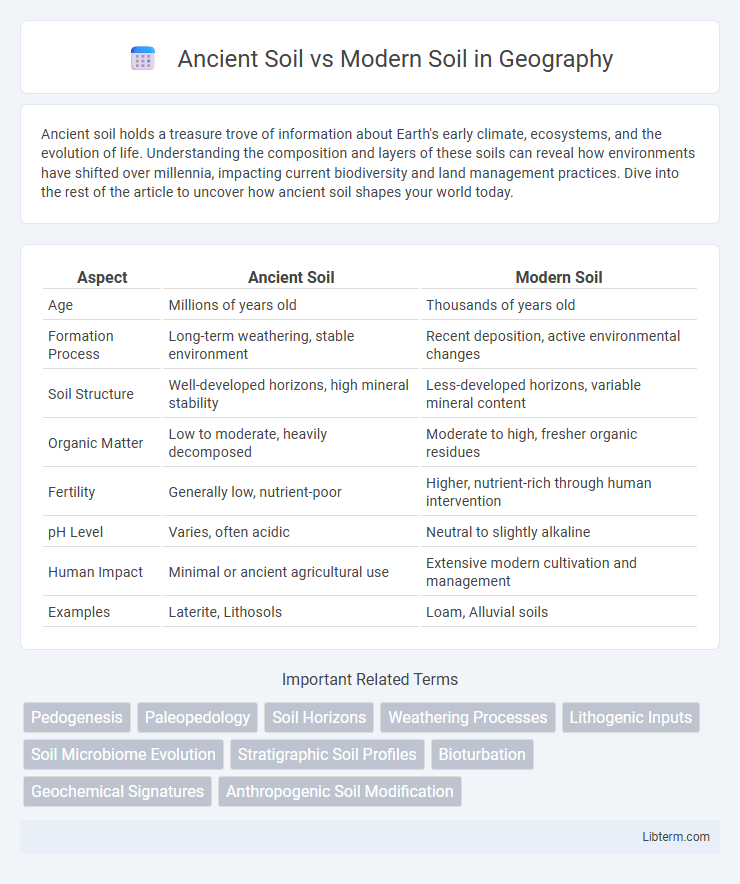Ancient soil holds a treasure trove of information about Earth's early climate, ecosystems, and the evolution of life. Understanding the composition and layers of these soils can reveal how environments have shifted over millennia, impacting current biodiversity and land management practices. Dive into the rest of the article to uncover how ancient soil shapes your world today.
Table of Comparison
| Aspect | Ancient Soil | Modern Soil |
|---|---|---|
| Age | Millions of years old | Thousands of years old |
| Formation Process | Long-term weathering, stable environment | Recent deposition, active environmental changes |
| Soil Structure | Well-developed horizons, high mineral stability | Less-developed horizons, variable mineral content |
| Organic Matter | Low to moderate, heavily decomposed | Moderate to high, fresher organic residues |
| Fertility | Generally low, nutrient-poor | Higher, nutrient-rich through human intervention |
| pH Level | Varies, often acidic | Neutral to slightly alkaline |
| Human Impact | Minimal or ancient agricultural use | Extensive modern cultivation and management |
| Examples | Laterite, Lithosols | Loam, Alluvial soils |
Introduction to Ancient Soil vs Modern Soil
Ancient soil, also known as paleosol, preserves the characteristics and composition of soils formed millions of years ago, offering insights into past climates and ecosystems. Modern soil develops from current geological and biological processes, reflecting recent environmental conditions and land use practices. Understanding the differences between ancient and modern soils enhances knowledge of soil evolution, fertility, and carbon storage capabilities.
Historical Formation of Ancient Soils
Ancient soils, also known as paleosols, formed over millions of years through complex processes such as weathering, sedimentation, and biological activity, preserving evidence of past climates and ecosystems. These soils exhibit distinct mineral compositions and structural characteristics shaped by prolonged periods of stability and geomorphological changes. In contrast, modern soils develop more rapidly under current environmental conditions, reflecting recent vegetation, climate, and human influence.
Modern Soil Characteristics and Composition
Modern soil typically exhibits a complex composition enriched with synthetic fertilizers, pesticides, and organic matter resulting from intensive agricultural practices. It contains a higher concentration of nutrients such as nitrogen, phosphorus, and potassium, but often suffers from reduced microbial diversity compared to ancient soil. The physical structure of modern soil can be compromised by compaction and reduced porosity, impacting water retention and root penetration.
Soil Fertility: Then and Now
Ancient soil exhibited high fertility due to natural processes such as long-term organic matter accumulation, balanced microbial activity, and nutrient cycling that supported sustainable agriculture. Modern soil often suffers from decreased fertility caused by intensive farming practices, soil erosion, chemical overuse, and reduced organic content, leading to nutrient depletion and lower crop yields. Advances in soil management, including crop rotation, organic amendments, and precision fertilization, aim to restore fertility and enhance soil health compared to ancient times.
Impact of Agriculture on Soil Evolution
Ancient soil formation was primarily influenced by natural processes such as weathering, organic matter accumulation, and mineral recycling, resulting in well-developed horizons and stable ecosystems. Modern soil evolution is significantly impacted by agriculture through practices like tillage, monoculture planting, and chemical fertilizer application, which alter soil structure, nutrient balance, and microbial diversity. These agricultural interventions accelerate soil erosion, reduce organic content, and contribute to salinization, fundamentally transforming soil properties compared to their ancient counterparts.
Nutrient Content: Ancient vs Modern Soils
Ancient soils typically exhibit higher organic matter and essential nutrient content due to long-term natural processes of accumulation and mineralization. Modern soils, often impacted by intensive agriculture and synthetic inputs, may suffer from nutrient imbalances and depletion of micronutrients such as zinc and iron. Soil management practices that restore microbial activity and organic carbon can enhance nutrient availability in modern soils, mimicking characteristics of ancient fertile soils.
Human Interventions and Soil Degradation
Human interventions such as intensive agriculture, deforestation, and industrial activities have accelerated soil degradation, reducing the natural fertility and structure of modern soils compared to ancient soils. Ancient soils, having developed over millennia with minimal disturbance, exhibit stable organic matter levels and balanced nutrient cycles, promoting sustainable ecosystems. Modern soil degradation manifests through erosion, nutrient depletion, compaction, and contamination, posing significant challenges for food security and environmental health.
Microbial Life and Biodiversity in Soils
Ancient soil harbors diverse microbial life, including archaea, bacteria, and fungi that have evolved over millennia, promoting complex symbiotic relationships and nutrient cycling essential for ecosystem stability. Modern soil often experiences reduced microbial diversity due to intensive agriculture, chemical fertilizers, and pesticides, leading to diminished soil health and resilience. Enhanced soil biodiversity in ancient soils supports robust organic matter decomposition and disease suppression, critical for sustainable plant growth and carbon sequestration.
Environmental Implications of Soil Changes
Ancient soil profiles often contain higher organic carbon content and stable mineral compositions, contributing to long-term ecosystem resilience and carbon sequestration. Modern soils, frequently altered by intensive agriculture and industrial activities, show increased erosion rates, nutrient depletion, and contamination from synthetic chemicals, leading to reduced fertility and greater greenhouse gas emissions. Soil degradation disrupts natural water regulation and biodiversity, accelerating environmental challenges such as climate change and habitat loss.
Regenerative Practices: Bridging Past and Present
Ancient soil management techniques, such as crop rotation and composting, laid the foundation for modern regenerative practices that restore soil health and biodiversity. By integrating traditional methods with contemporary innovations like cover cropping and reduced tillage, regenerative agriculture enhances carbon sequestration and nutrient cycling. This fusion of past wisdom and present science promotes sustainable farming systems that improve long-term soil fertility and ecosystem resilience.
Ancient Soil Infographic

 libterm.com
libterm.com